Perodua Marketing Report: Market Analysis, Objectives, and Strategies
VerifiedAdded on 2022/05/12
|25
|5884
|32
Report
AI Summary
This report provides a comprehensive analysis of Perodua, a Malaysian automobile manufacturer, focusing on its market position, marketing strategies, and future growth potential. The report begins with an introduction to Perodua, highlighting its history, key shareholders, and initial success in the Malaysian market with models like the Perodua Kancil. It then assesses the company's current market position, including its high market share in Malaysia and the need for international expansion. The report analyzes the company's product portfolio using a BCG matrix, identifies strengths, weaknesses, opportunities, and threats (SWOT analysis), and outlines marketing objectives, including product development, market penetration, and diversification. The report also details a proposed marketing plan, including offline and online marketing strategies, and concludes with a Gantt chart for implementation. The report suggests that the Indian market presents a viable opportunity for Perodua to expand its international presence and increase revenue. The report emphasizes the importance of foreign direct investment and the potential for market entry into India, given the country's large market volume and growth potential. The report utilizes figures, graphs, and references to support its findings and recommendations.

Running head: MARKETING
Marketing
Student’s Name
University Name
Author’s Note
Marketing
Student’s Name
University Name
Author’s Note
Paraphrase This Document
Need a fresh take? Get an instant paraphrase of this document with our AI Paraphraser
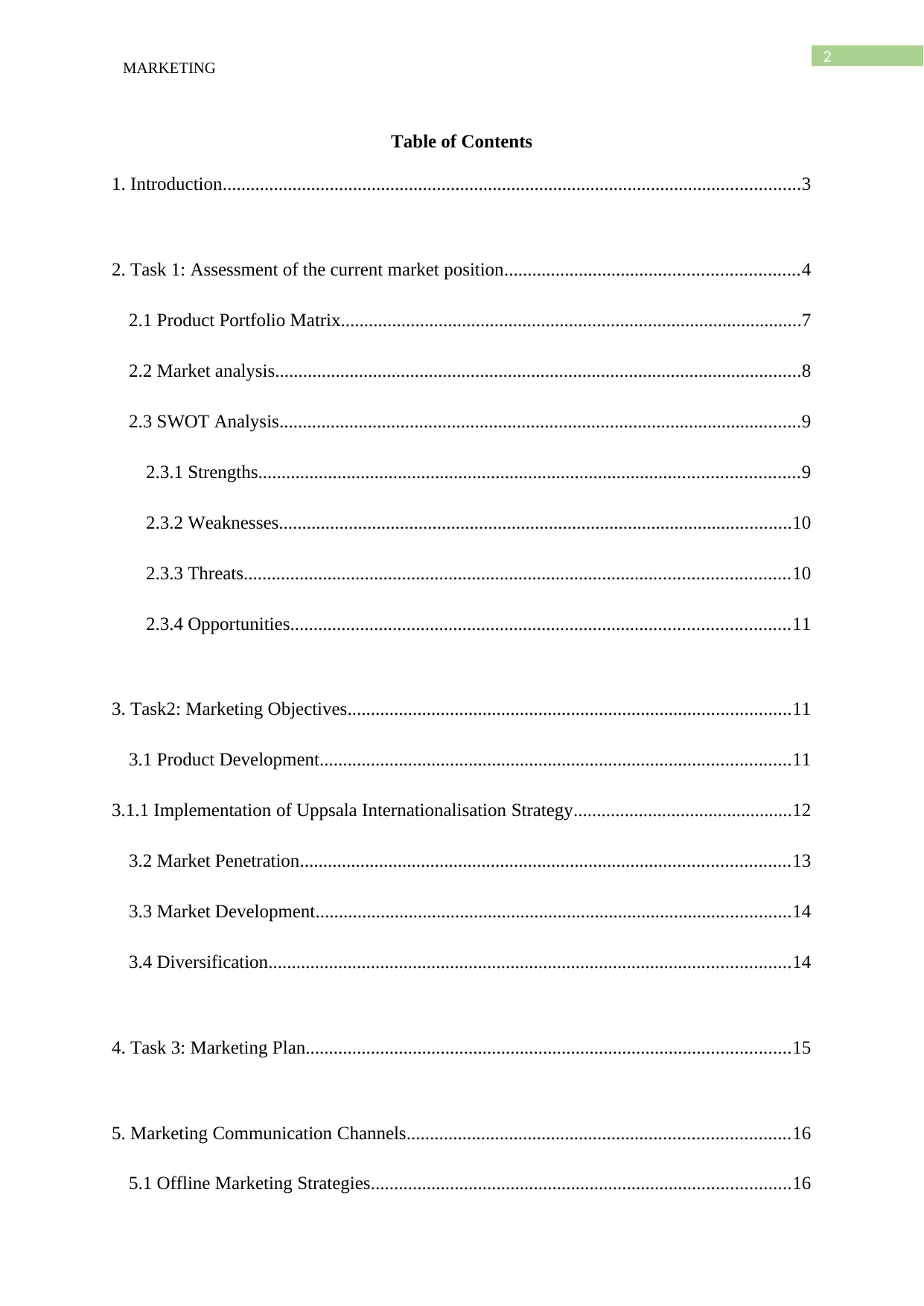
2
MARKETING
Table of Contents
1. Introduction............................................................................................................................3
2. Task 1: Assessment of the current market position...............................................................4
2.1 Product Portfolio Matrix...................................................................................................7
2.2 Market analysis.................................................................................................................8
2.3 SWOT Analysis................................................................................................................9
2.3.1 Strengths....................................................................................................................9
2.3.2 Weaknesses..............................................................................................................10
2.3.3 Threats.....................................................................................................................10
2.3.4 Opportunities...........................................................................................................11
3. Task2: Marketing Objectives...............................................................................................11
3.1 Product Development.....................................................................................................11
3.1.1 Implementation of Uppsala Internationalisation Strategy...............................................12
3.2 Market Penetration.........................................................................................................13
3.3 Market Development......................................................................................................14
3.4 Diversification................................................................................................................14
4. Task 3: Marketing Plan........................................................................................................15
5. Marketing Communication Channels..................................................................................16
5.1 Offline Marketing Strategies..........................................................................................16
MARKETING
Table of Contents
1. Introduction............................................................................................................................3
2. Task 1: Assessment of the current market position...............................................................4
2.1 Product Portfolio Matrix...................................................................................................7
2.2 Market analysis.................................................................................................................8
2.3 SWOT Analysis................................................................................................................9
2.3.1 Strengths....................................................................................................................9
2.3.2 Weaknesses..............................................................................................................10
2.3.3 Threats.....................................................................................................................10
2.3.4 Opportunities...........................................................................................................11
3. Task2: Marketing Objectives...............................................................................................11
3.1 Product Development.....................................................................................................11
3.1.1 Implementation of Uppsala Internationalisation Strategy...............................................12
3.2 Market Penetration.........................................................................................................13
3.3 Market Development......................................................................................................14
3.4 Diversification................................................................................................................14
4. Task 3: Marketing Plan........................................................................................................15
5. Marketing Communication Channels..................................................................................16
5.1 Offline Marketing Strategies..........................................................................................16
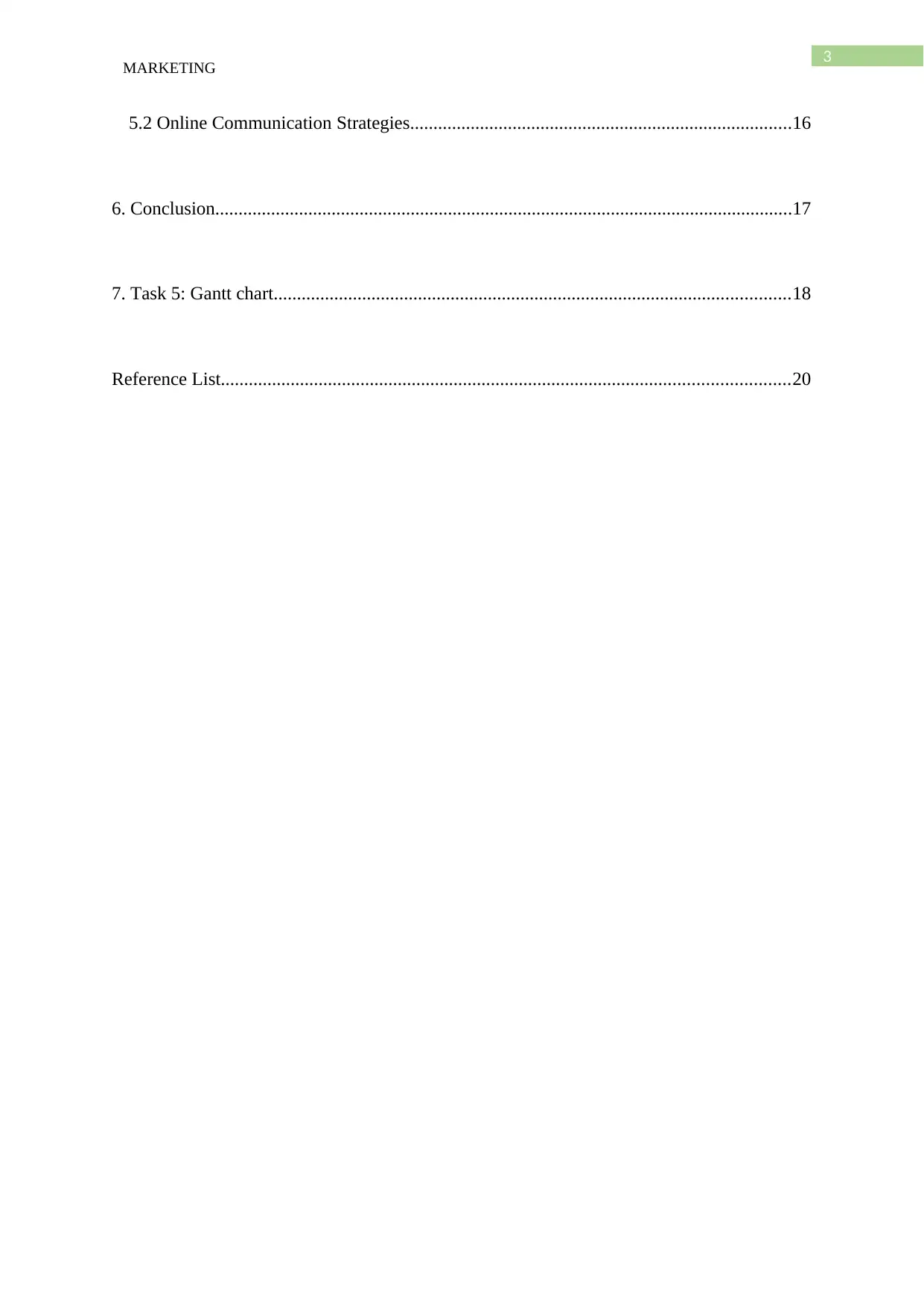
3
MARKETING
5.2 Online Communication Strategies..................................................................................16
6. Conclusion............................................................................................................................17
7. Task 5: Gantt chart...............................................................................................................18
Reference List..........................................................................................................................20
MARKETING
5.2 Online Communication Strategies..................................................................................16
6. Conclusion............................................................................................................................17
7. Task 5: Gantt chart...............................................................................................................18
Reference List..........................................................................................................................20
⊘ This is a preview!⊘
Do you want full access?
Subscribe today to unlock all pages.

Trusted by 1+ million students worldwide
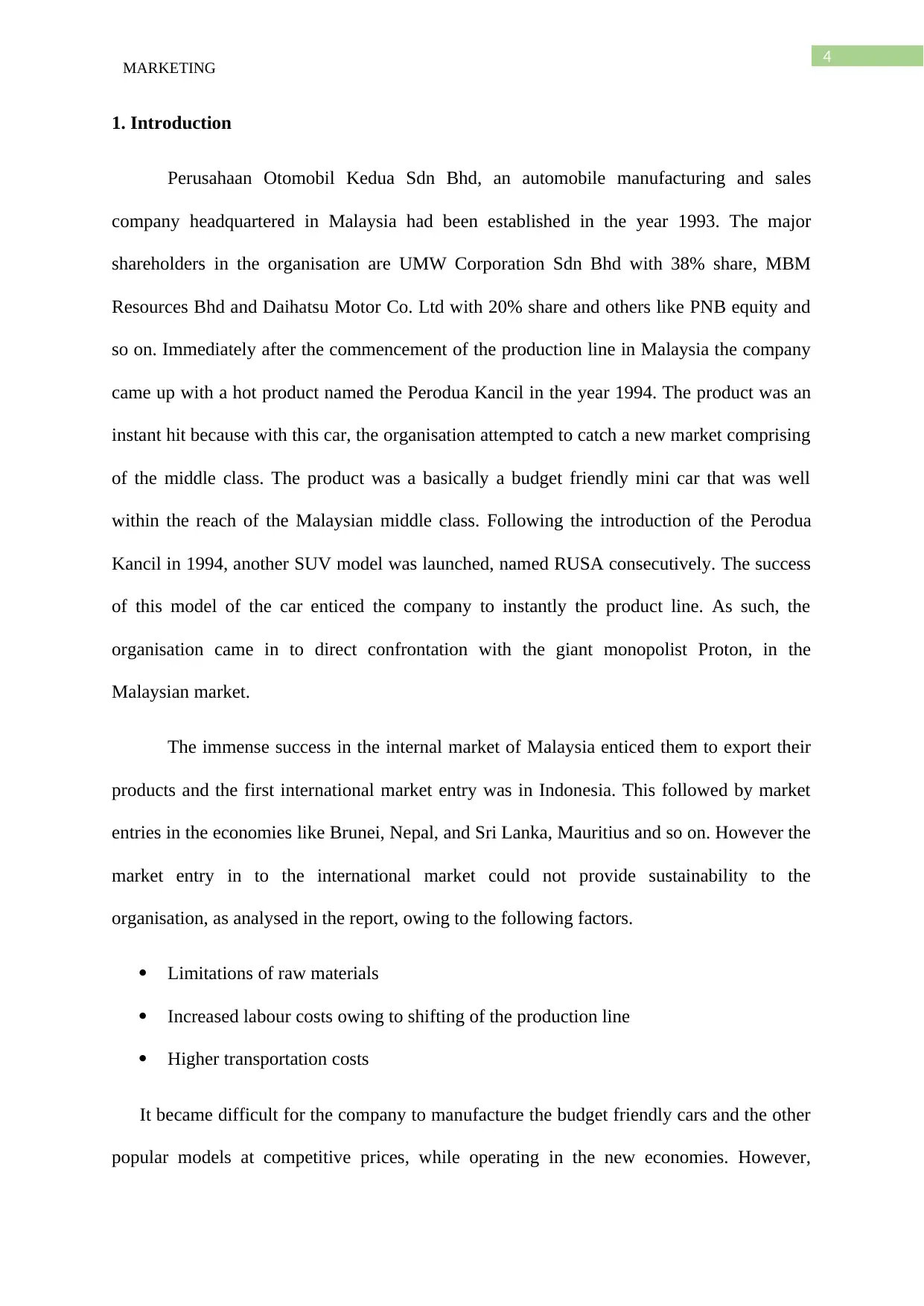
4
MARKETING
1. Introduction
Perusahaan Otomobil Kedua Sdn Bhd, an automobile manufacturing and sales
company headquartered in Malaysia had been established in the year 1993. The major
shareholders in the organisation are UMW Corporation Sdn Bhd with 38% share, MBM
Resources Bhd and Daihatsu Motor Co. Ltd with 20% share and others like PNB equity and
so on. Immediately after the commencement of the production line in Malaysia the company
came up with a hot product named the Perodua Kancil in the year 1994. The product was an
instant hit because with this car, the organisation attempted to catch a new market comprising
of the middle class. The product was a basically a budget friendly mini car that was well
within the reach of the Malaysian middle class. Following the introduction of the Perodua
Kancil in 1994, another SUV model was launched, named RUSA consecutively. The success
of this model of the car enticed the company to instantly the product line. As such, the
organisation came in to direct confrontation with the giant monopolist Proton, in the
Malaysian market.
The immense success in the internal market of Malaysia enticed them to export their
products and the first international market entry was in Indonesia. This followed by market
entries in the economies like Brunei, Nepal, and Sri Lanka, Mauritius and so on. However the
market entry in to the international market could not provide sustainability to the
organisation, as analysed in the report, owing to the following factors.
Limitations of raw materials
Increased labour costs owing to shifting of the production line
Higher transportation costs
It became difficult for the company to manufacture the budget friendly cars and the other
popular models at competitive prices, while operating in the new economies. However,
MARKETING
1. Introduction
Perusahaan Otomobil Kedua Sdn Bhd, an automobile manufacturing and sales
company headquartered in Malaysia had been established in the year 1993. The major
shareholders in the organisation are UMW Corporation Sdn Bhd with 38% share, MBM
Resources Bhd and Daihatsu Motor Co. Ltd with 20% share and others like PNB equity and
so on. Immediately after the commencement of the production line in Malaysia the company
came up with a hot product named the Perodua Kancil in the year 1994. The product was an
instant hit because with this car, the organisation attempted to catch a new market comprising
of the middle class. The product was a basically a budget friendly mini car that was well
within the reach of the Malaysian middle class. Following the introduction of the Perodua
Kancil in 1994, another SUV model was launched, named RUSA consecutively. The success
of this model of the car enticed the company to instantly the product line. As such, the
organisation came in to direct confrontation with the giant monopolist Proton, in the
Malaysian market.
The immense success in the internal market of Malaysia enticed them to export their
products and the first international market entry was in Indonesia. This followed by market
entries in the economies like Brunei, Nepal, and Sri Lanka, Mauritius and so on. However the
market entry in to the international market could not provide sustainability to the
organisation, as analysed in the report, owing to the following factors.
Limitations of raw materials
Increased labour costs owing to shifting of the production line
Higher transportation costs
It became difficult for the company to manufacture the budget friendly cars and the other
popular models at competitive prices, while operating in the new economies. However,
Paraphrase This Document
Need a fresh take? Get an instant paraphrase of this document with our AI Paraphraser
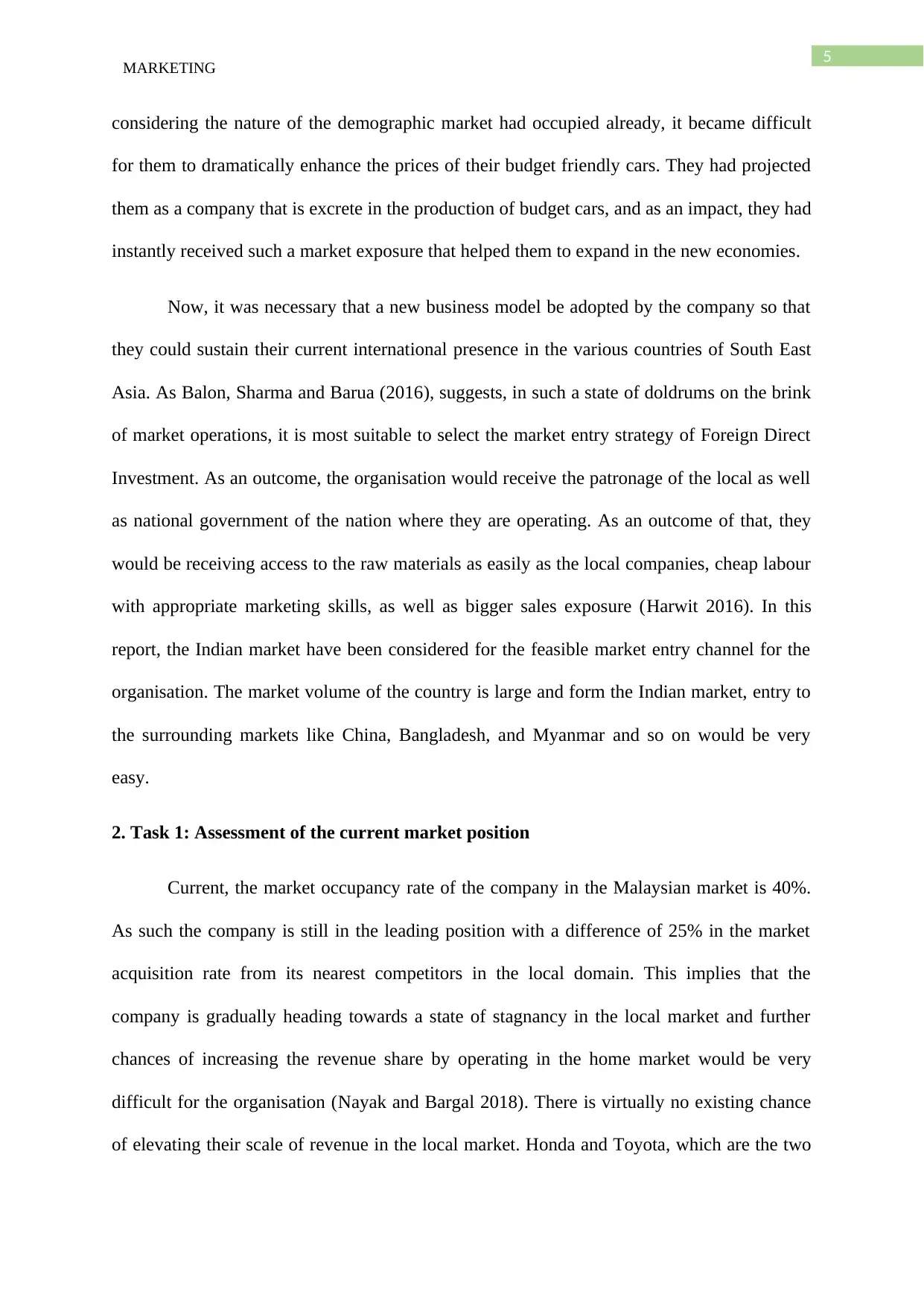
5
MARKETING
considering the nature of the demographic market had occupied already, it became difficult
for them to dramatically enhance the prices of their budget friendly cars. They had projected
them as a company that is excrete in the production of budget cars, and as an impact, they had
instantly received such a market exposure that helped them to expand in the new economies.
Now, it was necessary that a new business model be adopted by the company so that
they could sustain their current international presence in the various countries of South East
Asia. As Balon, Sharma and Barua (2016), suggests, in such a state of doldrums on the brink
of market operations, it is most suitable to select the market entry strategy of Foreign Direct
Investment. As an outcome, the organisation would receive the patronage of the local as well
as national government of the nation where they are operating. As an outcome of that, they
would be receiving access to the raw materials as easily as the local companies, cheap labour
with appropriate marketing skills, as well as bigger sales exposure (Harwit 2016). In this
report, the Indian market have been considered for the feasible market entry channel for the
organisation. The market volume of the country is large and form the Indian market, entry to
the surrounding markets like China, Bangladesh, and Myanmar and so on would be very
easy.
2. Task 1: Assessment of the current market position
Current, the market occupancy rate of the company in the Malaysian market is 40%.
As such the company is still in the leading position with a difference of 25% in the market
acquisition rate from its nearest competitors in the local domain. This implies that the
company is gradually heading towards a state of stagnancy in the local market and further
chances of increasing the revenue share by operating in the home market would be very
difficult for the organisation (Nayak and Bargal 2018). There is virtually no existing chance
of elevating their scale of revenue in the local market. Honda and Toyota, which are the two
MARKETING
considering the nature of the demographic market had occupied already, it became difficult
for them to dramatically enhance the prices of their budget friendly cars. They had projected
them as a company that is excrete in the production of budget cars, and as an impact, they had
instantly received such a market exposure that helped them to expand in the new economies.
Now, it was necessary that a new business model be adopted by the company so that
they could sustain their current international presence in the various countries of South East
Asia. As Balon, Sharma and Barua (2016), suggests, in such a state of doldrums on the brink
of market operations, it is most suitable to select the market entry strategy of Foreign Direct
Investment. As an outcome, the organisation would receive the patronage of the local as well
as national government of the nation where they are operating. As an outcome of that, they
would be receiving access to the raw materials as easily as the local companies, cheap labour
with appropriate marketing skills, as well as bigger sales exposure (Harwit 2016). In this
report, the Indian market have been considered for the feasible market entry channel for the
organisation. The market volume of the country is large and form the Indian market, entry to
the surrounding markets like China, Bangladesh, and Myanmar and so on would be very
easy.
2. Task 1: Assessment of the current market position
Current, the market occupancy rate of the company in the Malaysian market is 40%.
As such the company is still in the leading position with a difference of 25% in the market
acquisition rate from its nearest competitors in the local domain. This implies that the
company is gradually heading towards a state of stagnancy in the local market and further
chances of increasing the revenue share by operating in the home market would be very
difficult for the organisation (Nayak and Bargal 2018). There is virtually no existing chance
of elevating their scale of revenue in the local market. Honda and Toyota, which are the two

6
MARKETING
major competitors of the comp any in the Malaysian market are way behind the company at
25% market occupancy rate, each.
Figure 1: Overview of Automotive sales in the Malaysian Market
(Source: Luthra Garg and Haleem 2016)
As Kushwaha and Sharma (2016), states, it is evident that as the market occupancy
rate of the company in the Malaysian market is very high, there is an urgent need of exploring
the new markets that can help them in scanning up the revenue stream. The company has
entered the new countries so far with their existing business model that advocates licensed
partners who would be liable for the import of the cars of Perodua form Malaysia for sales in
the respective countries. However, as evidenced by Kale (2017), the cost of production in
Malaysia has increased considerably for the factors that are discussed above.
Analysing the market condition of the Asian countries, it can be discussed that the
growth potential for any new automobile manufacturing company is the highest in the Indian
market. That is why 3 to 4 new international car brands have opened up their sales units in
the Indian market. On top of that, all the major foreign car brand that are operating in India
MARKETING
major competitors of the comp any in the Malaysian market are way behind the company at
25% market occupancy rate, each.
Figure 1: Overview of Automotive sales in the Malaysian Market
(Source: Luthra Garg and Haleem 2016)
As Kushwaha and Sharma (2016), states, it is evident that as the market occupancy
rate of the company in the Malaysian market is very high, there is an urgent need of exploring
the new markets that can help them in scanning up the revenue stream. The company has
entered the new countries so far with their existing business model that advocates licensed
partners who would be liable for the import of the cars of Perodua form Malaysia for sales in
the respective countries. However, as evidenced by Kale (2017), the cost of production in
Malaysia has increased considerably for the factors that are discussed above.
Analysing the market condition of the Asian countries, it can be discussed that the
growth potential for any new automobile manufacturing company is the highest in the Indian
market. That is why 3 to 4 new international car brands have opened up their sales units in
the Indian market. On top of that, all the major foreign car brand that are operating in India
⊘ This is a preview!⊘
Do you want full access?
Subscribe today to unlock all pages.

Trusted by 1+ million students worldwide

7
MARKETING
are responsible for the manufacturing and/or assembly of their car parts in the country itself.
In fact, as Sharmelly and Ray (2016), states, there is high possibility of doubling of the sales
of all the major automobile brands in the Indian circuit by the year 2025. It can be estimated
that the company would enter in to the market with their existing exporting strategy and start
market occupancy with 2400 cars at least as they did with Singapore and Bahrain.
2019 2021 2023 2025
2400
3600
4000
4800
sales per unit
sales per unit
Graph 1: Apprehended sales by 2025 in India
(Source: Ray and Miglani, 2016)
Graph 2: The increment in the rate of automobile sales in India
MARKETING
are responsible for the manufacturing and/or assembly of their car parts in the country itself.
In fact, as Sharmelly and Ray (2016), states, there is high possibility of doubling of the sales
of all the major automobile brands in the Indian circuit by the year 2025. It can be estimated
that the company would enter in to the market with their existing exporting strategy and start
market occupancy with 2400 cars at least as they did with Singapore and Bahrain.
2019 2021 2023 2025
2400
3600
4000
4800
sales per unit
sales per unit
Graph 1: Apprehended sales by 2025 in India
(Source: Ray and Miglani, 2016)
Graph 2: The increment in the rate of automobile sales in India
Paraphrase This Document
Need a fresh take? Get an instant paraphrase of this document with our AI Paraphraser
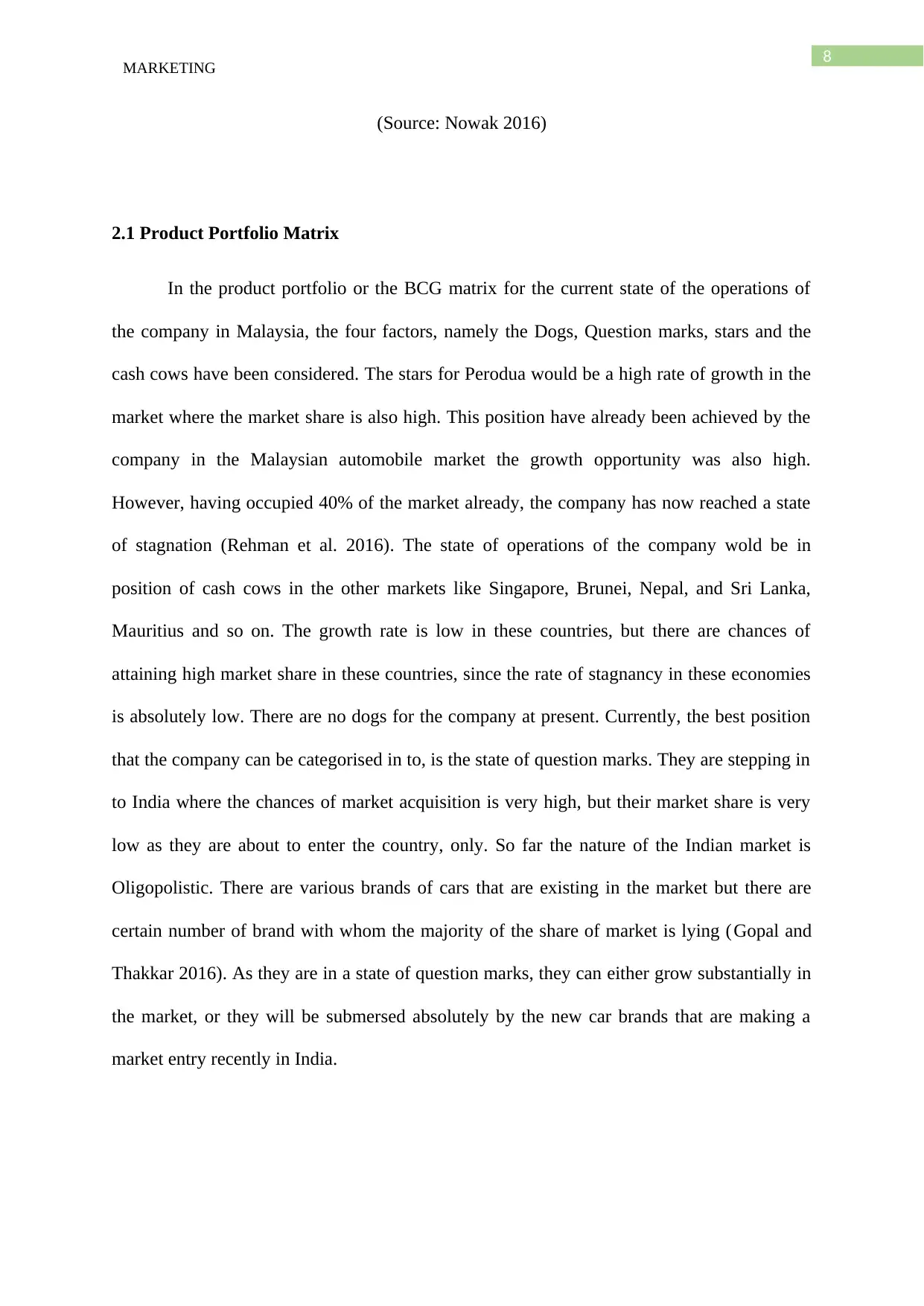
8
MARKETING
(Source: Nowak 2016)
2.1 Product Portfolio Matrix
In the product portfolio or the BCG matrix for the current state of the operations of
the company in Malaysia, the four factors, namely the Dogs, Question marks, stars and the
cash cows have been considered. The stars for Perodua would be a high rate of growth in the
market where the market share is also high. This position have already been achieved by the
company in the Malaysian automobile market the growth opportunity was also high.
However, having occupied 40% of the market already, the company has now reached a state
of stagnation (Rehman et al. 2016). The state of operations of the company wold be in
position of cash cows in the other markets like Singapore, Brunei, Nepal, and Sri Lanka,
Mauritius and so on. The growth rate is low in these countries, but there are chances of
attaining high market share in these countries, since the rate of stagnancy in these economies
is absolutely low. There are no dogs for the company at present. Currently, the best position
that the company can be categorised in to, is the state of question marks. They are stepping in
to India where the chances of market acquisition is very high, but their market share is very
low as they are about to enter the country, only. So far the nature of the Indian market is
Oligopolistic. There are various brands of cars that are existing in the market but there are
certain number of brand with whom the majority of the share of market is lying (Gopal and
Thakkar 2016). As they are in a state of question marks, they can either grow substantially in
the market, or they will be submersed absolutely by the new car brands that are making a
market entry recently in India.
MARKETING
(Source: Nowak 2016)
2.1 Product Portfolio Matrix
In the product portfolio or the BCG matrix for the current state of the operations of
the company in Malaysia, the four factors, namely the Dogs, Question marks, stars and the
cash cows have been considered. The stars for Perodua would be a high rate of growth in the
market where the market share is also high. This position have already been achieved by the
company in the Malaysian automobile market the growth opportunity was also high.
However, having occupied 40% of the market already, the company has now reached a state
of stagnation (Rehman et al. 2016). The state of operations of the company wold be in
position of cash cows in the other markets like Singapore, Brunei, Nepal, and Sri Lanka,
Mauritius and so on. The growth rate is low in these countries, but there are chances of
attaining high market share in these countries, since the rate of stagnancy in these economies
is absolutely low. There are no dogs for the company at present. Currently, the best position
that the company can be categorised in to, is the state of question marks. They are stepping in
to India where the chances of market acquisition is very high, but their market share is very
low as they are about to enter the country, only. So far the nature of the Indian market is
Oligopolistic. There are various brands of cars that are existing in the market but there are
certain number of brand with whom the majority of the share of market is lying (Gopal and
Thakkar 2016). As they are in a state of question marks, they can either grow substantially in
the market, or they will be submersed absolutely by the new car brands that are making a
market entry recently in India.

9
MARKETING
Figure 2: Product Portfolio Matrix for Perodua
(Source: Developed by the researcher)
2.2 Market analysis
Perodua has launched various models of cars in the Malaysian market by means of
which they are targeting various social classes. For evidence, the ViVa 660cc was introduced
for people who need low performance and are economical in expenses. The middle class
people have been targeted by the Myvi 1000cc and so on. The range of price for the various
models of cars are quite different (Gupta and Vardhan 2016). Versatility in the price range
enables people of various social classes to purchase the cars of Perodua. In the Malaysian
market, the prices of cars have become competitive recently, because of which the sales
monopoly that the car brand had, over a certain group of buyers is gradually diminishing.
That is why the car brand has taken the decision of providing with car loans ranging from 3.5
High growth with high
market share High growth market with
low market share
Low growth with high
market share Low growth or market
share
Current state of existence
of Perodua in the Indian
Market
MARKETING
Figure 2: Product Portfolio Matrix for Perodua
(Source: Developed by the researcher)
2.2 Market analysis
Perodua has launched various models of cars in the Malaysian market by means of
which they are targeting various social classes. For evidence, the ViVa 660cc was introduced
for people who need low performance and are economical in expenses. The middle class
people have been targeted by the Myvi 1000cc and so on. The range of price for the various
models of cars are quite different (Gupta and Vardhan 2016). Versatility in the price range
enables people of various social classes to purchase the cars of Perodua. In the Malaysian
market, the prices of cars have become competitive recently, because of which the sales
monopoly that the car brand had, over a certain group of buyers is gradually diminishing.
That is why the car brand has taken the decision of providing with car loans ranging from 3.5
High growth with high
market share High growth market with
low market share
Low growth with high
market share Low growth or market
share
Current state of existence
of Perodua in the Indian
Market
⊘ This is a preview!⊘
Do you want full access?
Subscribe today to unlock all pages.

Trusted by 1+ million students worldwide

10
MARKETING
to 4% and that also over a span of five to nine years. The customers need to pay only 100
Malaysian Ringgits as their instalments.
Although the sales locations of Perodua are variegated, most of their sales, services as
well as retail showrooms are located near the centres of urban population. As an evidence the
Perodua manufacturing as well as the engine as the engine manufacturing plan of the
company is located in Rawang and the sakes and the service centres of the company is
centered in Kuala Lumpur, Petaling Jaya, as well as Shah Alam and others. There are
multifarious sales channels also employed by the company like personal selling, advertising,
sales promotion and public relations. They have trained sales staff as well as promoters who
are liable to sell their products as well as provide product related information to the
individual based on their needs. In order to aggravate sales, the company provide a discount
of Malaysian Ringgits RM2000, free gifts like sterling locks, touch & go cards and so on.
They also have a feature of offering extended warranty program for the benefit of the
customers.
2.3 SWOT Analysis
2.3.1 Strengths
The first aspect of strength of the company is their product portfolio. In few years
only, the company have been able to create mentionable presence in various car models like
Bezza, Alza, and other sedans, hatchbacks like Axia and the Myvi. Their focus on the small
cars has increased their USP. Through the manufacturing and the servicing of the small cars
they have been able to gather high customer goodwill. Currently, Perodua is the market
leader in the sales of small cars in the Malaysian market. Another important strength of the
company is their business tie ups with the Japanese companies like Daihatsu and Mitsui (Jain,
MARKETING
to 4% and that also over a span of five to nine years. The customers need to pay only 100
Malaysian Ringgits as their instalments.
Although the sales locations of Perodua are variegated, most of their sales, services as
well as retail showrooms are located near the centres of urban population. As an evidence the
Perodua manufacturing as well as the engine as the engine manufacturing plan of the
company is located in Rawang and the sakes and the service centres of the company is
centered in Kuala Lumpur, Petaling Jaya, as well as Shah Alam and others. There are
multifarious sales channels also employed by the company like personal selling, advertising,
sales promotion and public relations. They have trained sales staff as well as promoters who
are liable to sell their products as well as provide product related information to the
individual based on their needs. In order to aggravate sales, the company provide a discount
of Malaysian Ringgits RM2000, free gifts like sterling locks, touch & go cards and so on.
They also have a feature of offering extended warranty program for the benefit of the
customers.
2.3 SWOT Analysis
2.3.1 Strengths
The first aspect of strength of the company is their product portfolio. In few years
only, the company have been able to create mentionable presence in various car models like
Bezza, Alza, and other sedans, hatchbacks like Axia and the Myvi. Their focus on the small
cars has increased their USP. Through the manufacturing and the servicing of the small cars
they have been able to gather high customer goodwill. Currently, Perodua is the market
leader in the sales of small cars in the Malaysian market. Another important strength of the
company is their business tie ups with the Japanese companies like Daihatsu and Mitsui (Jain,
Paraphrase This Document
Need a fresh take? Get an instant paraphrase of this document with our AI Paraphraser
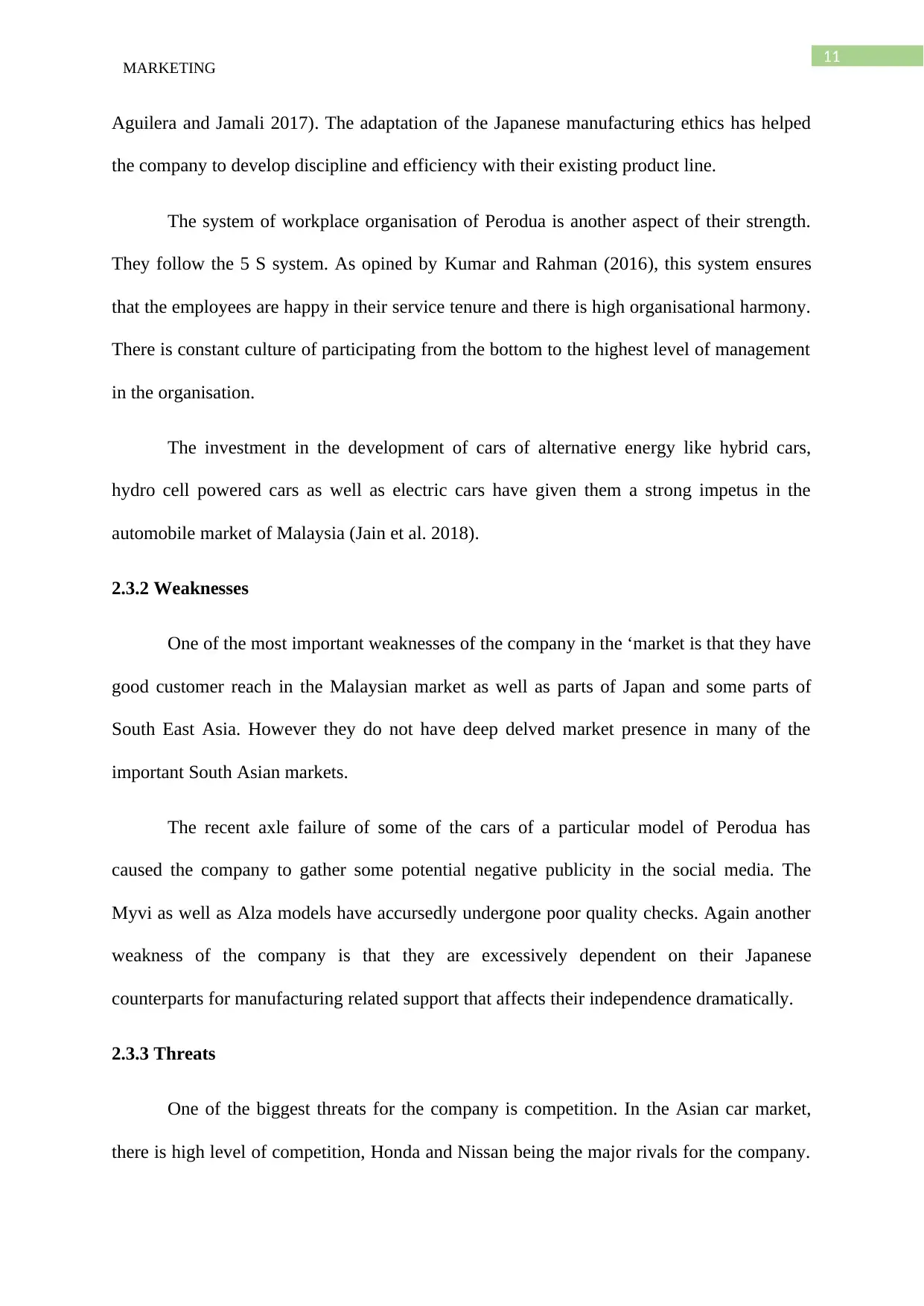
11
MARKETING
Aguilera and Jamali 2017). The adaptation of the Japanese manufacturing ethics has helped
the company to develop discipline and efficiency with their existing product line.
The system of workplace organisation of Perodua is another aspect of their strength.
They follow the 5 S system. As opined by Kumar and Rahman (2016), this system ensures
that the employees are happy in their service tenure and there is high organisational harmony.
There is constant culture of participating from the bottom to the highest level of management
in the organisation.
The investment in the development of cars of alternative energy like hybrid cars,
hydro cell powered cars as well as electric cars have given them a strong impetus in the
automobile market of Malaysia (Jain et al. 2018).
2.3.2 Weaknesses
One of the most important weaknesses of the company in the ‘market is that they have
good customer reach in the Malaysian market as well as parts of Japan and some parts of
South East Asia. However they do not have deep delved market presence in many of the
important South Asian markets.
The recent axle failure of some of the cars of a particular model of Perodua has
caused the company to gather some potential negative publicity in the social media. The
Myvi as well as Alza models have accursedly undergone poor quality checks. Again another
weakness of the company is that they are excessively dependent on their Japanese
counterparts for manufacturing related support that affects their independence dramatically.
2.3.3 Threats
One of the biggest threats for the company is competition. In the Asian car market,
there is high level of competition, Honda and Nissan being the major rivals for the company.
MARKETING
Aguilera and Jamali 2017). The adaptation of the Japanese manufacturing ethics has helped
the company to develop discipline and efficiency with their existing product line.
The system of workplace organisation of Perodua is another aspect of their strength.
They follow the 5 S system. As opined by Kumar and Rahman (2016), this system ensures
that the employees are happy in their service tenure and there is high organisational harmony.
There is constant culture of participating from the bottom to the highest level of management
in the organisation.
The investment in the development of cars of alternative energy like hybrid cars,
hydro cell powered cars as well as electric cars have given them a strong impetus in the
automobile market of Malaysia (Jain et al. 2018).
2.3.2 Weaknesses
One of the most important weaknesses of the company in the ‘market is that they have
good customer reach in the Malaysian market as well as parts of Japan and some parts of
South East Asia. However they do not have deep delved market presence in many of the
important South Asian markets.
The recent axle failure of some of the cars of a particular model of Perodua has
caused the company to gather some potential negative publicity in the social media. The
Myvi as well as Alza models have accursedly undergone poor quality checks. Again another
weakness of the company is that they are excessively dependent on their Japanese
counterparts for manufacturing related support that affects their independence dramatically.
2.3.3 Threats
One of the biggest threats for the company is competition. In the Asian car market,
there is high level of competition, Honda and Nissan being the major rivals for the company.

12
MARKETING
Another threats for Perodua is the depreciation in the currency value (Jamali and Jain 2017).
The depreciation in the valuation of the Malaysian Ringgit will affect the business of the
company since Perodua imports in the currencies like Dollar and Yen. In future, they might
need to diminish the costs of product vehemently in order to compete with force against the
rate of havoc depreciation.
2.3.4 Opportunities
The market potential of the company is huge. They are the market leader in smaller
cars in Malaysia and the cars in the same segment have gained ample popularity in countries
like India where there is a large demographic base of customers who financially equipped to
purchase cars from their range of small cars.
Many of the newly emerging economies like India are giving enhanced focus on
connection of their cities through road ways like high ways as well as super highways
(Rehman, Aneyrao and Shrivastava 2015). This would call in demand of the cars like sedans
and the SUVs that is adaptable for heavy journey along high ways.
The change of the current trends in the automotive industry also provides an
opportunity for the company. The increase of dual income households in countries of South
East Asia, higher rate of urban population as well as others are having a high impact on the
sale of cars in the countries like India as estimated above in this report also (Nakamichi,
Hanaoka and Kawahara, 2016).
3. Task2: Marketing Objectives
3.1 Product Development
The product development strategy for Perodua in the Indian market is simple.
However, there is high need for diversification of the product line. Initially, the company
MARKETING
Another threats for Perodua is the depreciation in the currency value (Jamali and Jain 2017).
The depreciation in the valuation of the Malaysian Ringgit will affect the business of the
company since Perodua imports in the currencies like Dollar and Yen. In future, they might
need to diminish the costs of product vehemently in order to compete with force against the
rate of havoc depreciation.
2.3.4 Opportunities
The market potential of the company is huge. They are the market leader in smaller
cars in Malaysia and the cars in the same segment have gained ample popularity in countries
like India where there is a large demographic base of customers who financially equipped to
purchase cars from their range of small cars.
Many of the newly emerging economies like India are giving enhanced focus on
connection of their cities through road ways like high ways as well as super highways
(Rehman, Aneyrao and Shrivastava 2015). This would call in demand of the cars like sedans
and the SUVs that is adaptable for heavy journey along high ways.
The change of the current trends in the automotive industry also provides an
opportunity for the company. The increase of dual income households in countries of South
East Asia, higher rate of urban population as well as others are having a high impact on the
sale of cars in the countries like India as estimated above in this report also (Nakamichi,
Hanaoka and Kawahara, 2016).
3. Task2: Marketing Objectives
3.1 Product Development
The product development strategy for Perodua in the Indian market is simple.
However, there is high need for diversification of the product line. Initially, the company
⊘ This is a preview!⊘
Do you want full access?
Subscribe today to unlock all pages.

Trusted by 1+ million students worldwide
1 out of 25
Your All-in-One AI-Powered Toolkit for Academic Success.
+13062052269
info@desklib.com
Available 24*7 on WhatsApp / Email
![[object Object]](/_next/static/media/star-bottom.7253800d.svg)
Unlock your academic potential
Copyright © 2020–2025 A2Z Services. All Rights Reserved. Developed and managed by ZUCOL.


